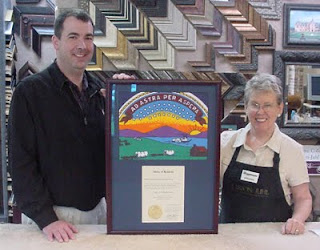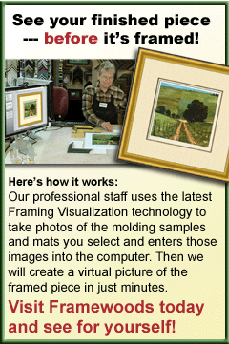In 1998 the White House launched the Save America's Treasures Project. As part of that program, the Smithsonian Institute’s National Museum of American History, conservators worked to preserve the actual American flag that inspired Francis Scott Key’s “Star Spangled Banner.” Since the flag was made in 1813, it has endured the War of 1812 and over 200 years of wear and tear. In fact, the family that owned the flag before donating it to the Smithsonian in 1912 used to give clippings of the flag as gifts. Throughout the preservation process, the flag was kept on display. Visitors were able to view the flag for a few hours each day, before and after which the flag’s display case is covered to protect it from unnecessary (and possibly harmful) exposure to light.
What about your treasures? Are there items, artwork, and photos that you would like to see stand the test of time to be enjoyed for years to come? Preservation framing available at Framewoods of Topeka can achieve this.
Jeff Bottenberg understands the importance of preservation framing for his treasures:
"I recently went to Framewoods of Topeka to get my Kansas flag and proclamation from Governor Parkinson framed. I was a legal assistance attorney (JAG) with my National Guard unit at COB Adder, Iraq from February-September, 2009. While deployed, Governor Parkinson was nice enough to fly a flag over the Capital for me and some of my fellow Soldiers, as well as issue the accompanying proclamations.
Appollonia did an outstanding job on my project and I always enjoy working with Gary and his staff as they do outstanding work!" - Jeff Bottenberg (pictured)
There are many materials available that we can use to protect items from the effects of environmental concerns—even those, like Old Glory, which may already be damaged. For example, there are matboards made from 100% cotton fiber (rag board) or purified wood pulp that are free of acid and lignin found in most paper products. This acid and lignin can cause chemical reactions that degrade the materials over time. By using preservation-quality matboard, we can ensure that this process is slowed dramatically. For example, the Gutenberg Bible, which has survived since the 15th century, is made of rag paper.
The glazing we use is also important in preservation. Glazing is either the glass or acrylic sheet used on the face of a frame package. These are available with properties that filter out ultraviolet (UV) rays from sunlight and some artificial light as well. Most of these specially treated materials filter out up to 99% of the light rays that can fade framed items.
The Art&Framing Council (AFC) offers some tips about protecting your art from light damage: Choose subdued lighting effects that won’t reflect into the glazing; never hang artwork in direct sunlight; and never use fluorescent lights to illuminate artwork since their UV concentrations are very high. (Incandescent bulbs are a better choice.)
Also, take a look at the things you have that are already framed. If you see signs of degrading materials, such as faded colors or condensation and water damage under the glazing, bring them into our shop and we’ll evaluate it with you to see if it should be reframed with preservation needs in mind. We’ll help you save your personal treasures with the same preservation materials and care as if they were national treasures!
Framewoods.com
Tuesday, May 4, 2010
Save Your Treasures - Kansas Flag and Proclamation
Labels:
Decorating,
frame design,
Framing Tips,
memorabilia,
picture frame
Subscribe to:
Post Comments (Atom)



No comments:
Post a Comment